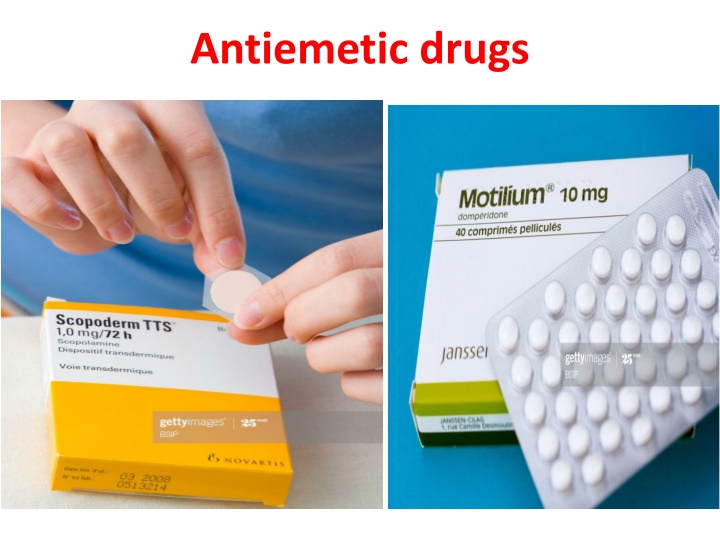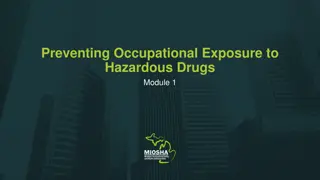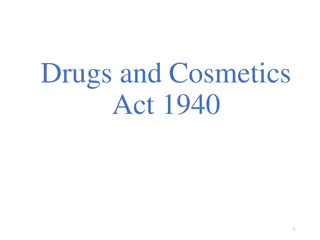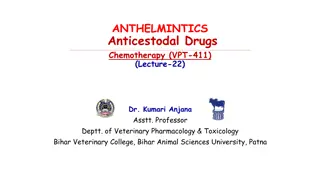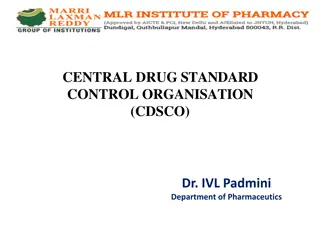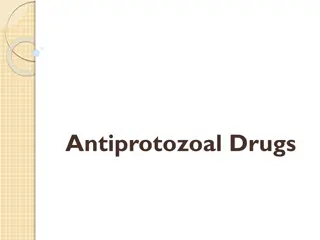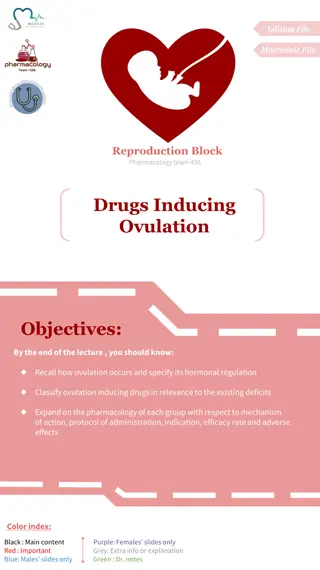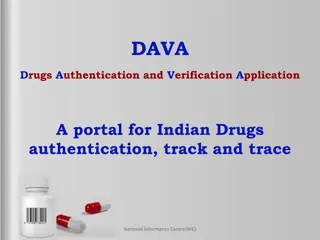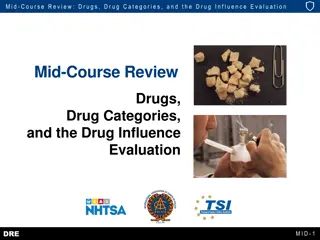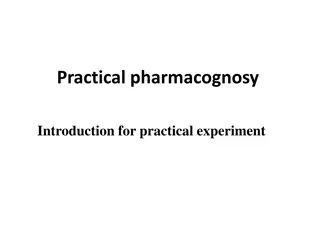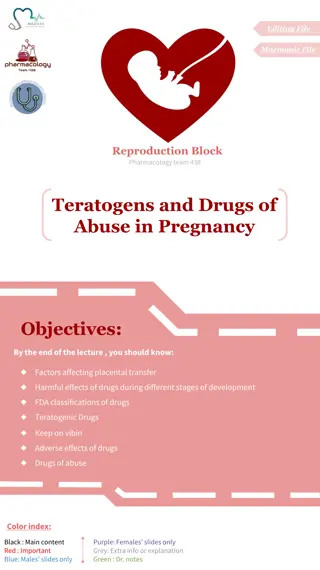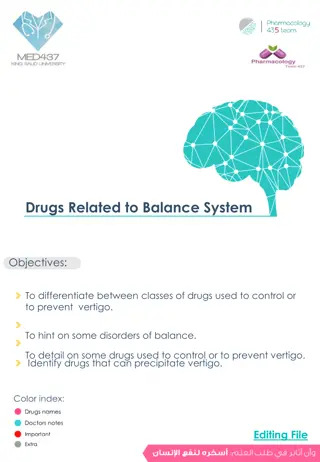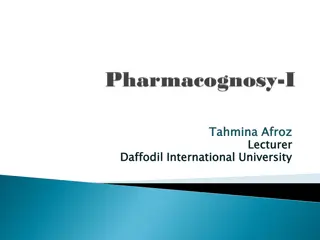Antiemetic drugs
Antiemetic drugs are used to manage vomiting in various conditions such as motion sickness, pregnancy, gastrointestinal illnesses, and chemotherapy-induced nausea and vomiting. This includes a classification of antiemetic drugs based on mechanisms of action, with examples like antimuscarinic drugs, antihistamines, dopamine receptor antagonists, 5-HT3 receptor antagonists, and more. Specific drugs like metoclopramide, domperidone, and prochlorperazine are discussed, highlighting their mechanisms and uses in treating nausea and vomiting. Adverse effects and considerations for each drug are also covered.
Download Presentation

Please find below an Image/Link to download the presentation.
The content on the website is provided AS IS for your information and personal use only. It may not be sold, licensed, or shared on other websites without obtaining consent from the author.If you encounter any issues during the download, it is possible that the publisher has removed the file from their server.
You are allowed to download the files provided on this website for personal or commercial use, subject to the condition that they are used lawfully. All files are the property of their respective owners.
The content on the website is provided AS IS for your information and personal use only. It may not be sold, licensed, or shared on other websites without obtaining consent from the author.
E N D
Presentation Transcript
Antiemetic drugs Used in vomiting due to different causes: Motion sickness, pregnancy, GIT illness, and chemotherapy induced nausea & vomiting (CINV). CINV influenced by several factors: 1. Type of anticancer drug: cisplatin MTX 2. Patient variables: young old, women men. Anticipatory vomiting 10-40%
Mechanisms that trigger vomiting Two brainstem sites have roles in vomiting: 1. Chemoreceptor trigger zone (CTZ): it is outside BBB. Directly respond to stimuli in blood or CSF. 2. Vomiting center: also responds to afferent input from vestibular system & periphery (pharynx & GI tract). Vestibular system functions mainly in motion sickness.
Classification: 1. Antimuscarinic drugs: hyoscine, scopolamine 2. Antihistamines: cyclizine, meclizine 3. Dopamine receptors antagonists: metoclopramide, domperidone, prochlorperazine 4. 5-HT3 receptors antagonists: ondansetron 5. Other agents: corticosteroids, benzodiazepines 6. Neurokinin receptor (NK1) antagonist: aprepitant
Metoclopramide: Acts centrally by blocking dopamine D2 receptors in CTZ. Metoclopramide antagonizes the emetic effect mediated by a dopamine receptor in the CNS. It also raises the lower esophageal sphincter pressure and relaxes the pyloric sphincter, which hastens gastric emptying time. This makes it useful in the therapy of reflux esophagitis. Metoclopramide is metabolized by the liver with a half-life of 4 hours.
Uses 1. Nauseas and vomiting associated with gastrointestinal diseases 2. Cytotoxic and radiotherapy induced vomiting 3. In migraine to relief nausea & vomiting and increase absorption of analgesics 4. To empty the stomach in emergency anesthesia 5. Gastroparesis
Adverse effects 1. extra-pyramidal dystonia (torticollis, facial spasm, oculogyric crisis), more common in children and young adults (treated with benztropine or antihistamines) 2. Diarrhea (prevented by corticosteroid) 3. stimulation of prolactin release with gynaecomastia and galactorrhea
Domperidone selective dopamine D2 receptors antagonist. The half-life is about 7 hours. It is used for the treatment of nausea and vomiting associated with gastrointestinal disorders, cytotoxic induced vomiting, & gastroparesis. May cause gynaecomastia and galactorrhoea Prochlorperazine Act by blocking dopamine receptors in CTZ.
Ondansetron Is a selective 5-HT3 receptors antagonist in CTZ & peripheral vesceral vagal fibers. Ondansetron & granisetron are highly effective against nausea and vomiting by cytotoxic drugs and radiotherapy. Cause constipation, headache and facial flushing Safe in children & in pregnancy
Corticosteroids as dexamethasone & methylprednisolone Also effective in cytotoxic drugs induced vomiting, probably act by reducing oedema in vomiting centers or PG blockade. Combination with other antiemetics increases their activity. Benzodiazepines: lorazepam & alprazolam Useful in treating anticipatory vomiting
Neurokinin-1 antagonists Aprepitant target neurokinin receptor in the vomiting center & block action of substance P. Is indicated for highly or moderately emetogenic chemotherapy. Usually in combination with dexamethosone & ondansetrone Effective for delayed phase (24 hrs) of chemotherapy induced N/V
Motion sickness Drugs are more effective prophylactically Scopalamine is used for motion sickness and postoperative N&V H1-blockers: dimenhydrinate, cyclizine, meclizine(also for pregnancy & vestibular vertigo)
Antidiarrheal drugs 1. Antimotility drugs as: codeine, diphenoxylate and loperamide 2. Drugs increase viscosity of feces & as adsorbents: Kaolin & methylcellulose Codeine: Acts on the opioid receptors in the smooth muscles of the bowel to reduce peristalsis and increase segmentation contraction
Diphenoxylate Has an effect similar to codeine. Usually given mixed with atropine (Lomotil). It causes nausea, vomiting abdominal; pain and CNS depression.
Loperamide: Also an opiate act by inhibiting contraction of the smooth muscles of the intestine. It also causes nausea, abdominal pain and vomiting. All the anti-motility drugs should not be given to children with acute diarrhea as they may cause paralytic ileus and respiratory depression
Adsorbents Aluminum hydroxide & methylcellulose are used to adsorb intestinal toxins or microorganisms and coating intestinal mucosa; Bismuth subsalicylate used for traveler s diarrhea. Kaolin mixture used for children
MCQ Metoclopramide has antiemetic properties because it a. Accelerates gastric emptying time b. Lowers esophageal sphincter pressure c. Is a central nervous system (CNS) dopamine- receptor antagonist d. Has cholinomimetic properties e. Has sedative properties
MCQ Extrapyramidal symptoms are side effect of which one of the following antiemetic drugs A. Metoclopramide B. Dimenhydrinate C. Cyclizine D. Ondansetron E. Scopolamine (A)
MCQ A patient has to be urgently operated upon under general anesthesia; which drug can be administered to hasten gastric emptying? A. Metoclopramide B. Hyoscine C. Promethazine D. Ondansetron E. Prochlorperazine (A)
MCQ A 55-year-old woman with type 1 diabetes of 40 years duration complains of severe bloating and abdominal distress, especially after meals. Evaluation is consistent with diabetic gastroparesis. Which of the following drugs could be used in this situation? (A) Alosetron (B) Cimetidine (C) Loperamide (D) Metoclopramide (E) Sucralfate
MCQ A patient is receiving highly emetogenic chemotherapy for metastatic carcinoma. To prevent chemotherapy-induced nausea and vomiting, she is likely to be treated with which of the following? (A) Levodopa (B) Methotrexate (C) Misoprostol (D) Ondansetron (E) Sucralfate
MCQ Metoclopramide has all the following features EXCEPT: ( c ) A. Acts by blocking dopamine D2receptors centrally B. Increases the tone of the esophageal sphincter and relaxes the pyloric sphincter C. Delays the absorption of analgesic drugs during acute migraine attack D. Is useful in nausea and vomiting induced by cytotoxic drugs E. May cause extrapyramidal dystonia in young patients
MCQ One of the stated mechanisms is correct for anti- emetic drugs (b) A. Ondansetron is agonist at 5HT3 receptors B. Aprepitant is highly selective neurokinin (NK1) receptor antagonist C. Nabilone acts mainly as dopamine D2 receptor blocker D. Metoclopramide is a centrally acting dopamine agonist E. Hyoscine is a centrally acting antihistamine
MCQ The main clinical use of loperamide is: A. Vomiting of motion sickness B. Diarrhea C. Reflux esophagitis D. Constipation E. Dyspepsia (B)
MCQ Which of the following drugs is used for treatment of diarrhea ?[b] A. bisacodyl B. diphenoxylate C. senna D. lactoluse E. glycerol
